NRAO eNews
Volume 10, Issue 6
6 July 2017
Upcoming Events

Community Day: Cornell University
July 10 - 11, 2017 | Ithaca, NY

Fred Lo Science Symposium
July 24 - 26, 2017 | Charlottesville, VA

5th U.S. – China Workshop on Radio Astronomy Science & Technology
July 27 - 29, 2017 | Charlottesville, VA

Futures III
Aug 2 - 4, 2017 | Berkeley, CA
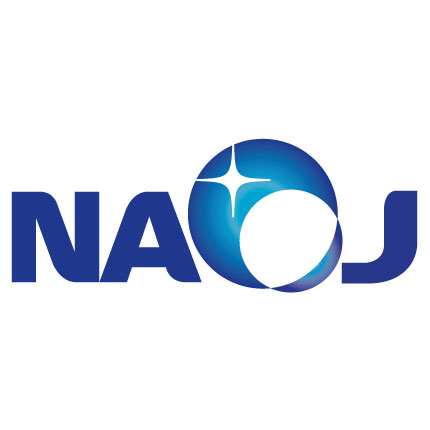
ALMA Long Baseline Workshop
Oct 3 - 5, 2017 | Mielparque Kyoto, Japan

6th VLA Data Reduction Workshop
Oct 23 - 27, 2017 | Socorro, NM

2017 Jansky Lecture
Oct 25, 2017 | Charlottesville, VA

2017 Jansky Lecture
Oct 27, 2017 | Green Bank Observatory, WV

2017 Jansky Lecture
Nov 3, 2017 | Socorro, NM
NRAO Call for Proposals: Semester 2018A

The National Radio Astronomy Observatory (NRAO) invites scientists to participate in the Semester 2018A Call for Proposals for the Karl G. Jansky Very Large Array (VLA).
The submission deadline for Semester 2018A proposals is Tuesday, 1 August 2017, at 17:00 EST (21:00 UTC).
The NRAO especially wishes to highlight continuing opportunities for joint observations with the Chandra X-ray Observatory, the Hubble Space Telescope and the Swift Gamma-Ray Burst Mission.
Proposal preparation and submission are via the NRAO Proposal Submission Tool (PST) available at NRAO Interactive Services. Note that PST use requires registration. Proposers who need assistance with proposal preparation or have questions regarding the Call or NRAO telescope capabilities should contact Observatory staff via the NRAO Helpdesk.
VLA Sky Survey Update: observing to begin in September
The VLA Sky Survey (VLASS) is a multi-epoch, all-sky S-band (2 – 4 GHz) survey to be carried out in the VLA B-configuration. The VLASS Project Team has been working closely with the Survey Science Group, chaired by Shami Chatterjee (Cornell) and Stefi Baum (U. Manitoba), on the survey design and recently carried out a successful Critical Design Review (CDR). The Review Panel, chaired by Joe McMullin (Daniel K. Inouye Solar Telescope), noted that the VLASS Project Team is uniquely poised to deliver a survey with fantastic science potential.
Using an improved and enhanced Common Astronomy Software Applications (CASA) package Calibration Pipeline, and a new Imaging Pipeline, NRAO will deliver a number of basic data products (BDPs) from the Survey:
- Calibrated visibility data
- Stokes I wideband continuum images
- Stokes IQU spectral cubes with 128 MHz and 16 MHz spectral resolution
- Basic radio source catalogs.
In addition, several groups from the U.S. and international astronomy community are seeking funding to deliver enhanced data products (EDPs), such as rotation measures and transient alerts.
All data products will be publicly available after undergoing quality assurance.
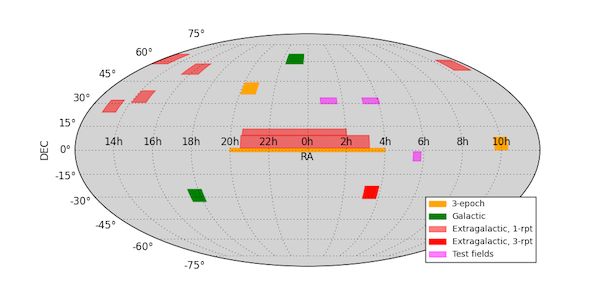
VLASS Pilot Sky Coverage
[click to enlarge]
In 2016, the Survey Team undertook a ~200-hour Pilot survey covering 2270 square degrees, including the key extragalactic fields Stripe 82, GOODS-N, Chandra Deep Field South, and COSMOS, as well as parts of the Galactic Plane in Cepheus, Cygnus, and the Galactic Center. The Survey Team is currently working on delivering initial images from the Pilot using the CASA calibration and imaging pipelines noted above, and preparing to start observing the full survey in September. Further information on the VLA Sky Survey, including the Pilot data, is available on-line.
Submillimeter Array (SMA) Call for Observing Proposals

The joint CfA – ASIAA SMA Time Allocation Committee solicits proposals for observations for the period 16 November 2017 – 15 May 2018 (2017B semester). The deadline for submitting proposals is 06 September 2017.
The SMA Observer Center website is expected to open for proposal submission on 15 August 2017.
The SMA also invites proposals for large-scale observing projects dedicated to answering major astrophysical questions having significant scientific impact. More details can be found online.
The SMA has recently completed significant upgrades in observational capability, with more underway. Currently, the SMA observes simultaneously with two orthogonally polarized receivers, one in the 230 GHz or 345 GHz band and the other in the 240 GHz or 400 GHz band (with full polarimetric observations available using the 230+240 or 345+400 band combinations). The SWARM correlator processes 8 GHz bandwidth for each receiver in each sideband, for a total of 32 GHz, at a uniform 140 kHz resolution. This 32 GHz frequency coverage can be continuous where the tuning ranges overlap for the two orthogonally polarized receivers. In short, the SMA now provides flexible, wide band frequency coverage that delivers much improved continuum sensitivity and excellent spectral line capabilities. A full track offers continuum sensitivity of 200 or 500 micro-Jy (1 sigma) at 230 or 345 GHz in good weather conditions (precipitable water vapor 2.5mm and 1.0mm, respectively). The corresponding line sensitivities at 1 km/s resolution are 30 and 70 mJy. The small antennas allow access to low spatial frequencies in the sub-compact configuration and the finest angular resolution at 345 GHz in the very extended configuration is ~ 0.25". Thus, in some ways, the characteristics of the SMA may be both similar and complementary to those of the stand-alone Atacama Compact Array (ACA) component of ALMA. For more information about SMA capabilities visit the SMA Observer Center website, and explore the set of SMA proposing tools. The SMA Newletters available online provide a sampling of the wide variety of science possible with the SMA.
Women in Astronomy IV Conference
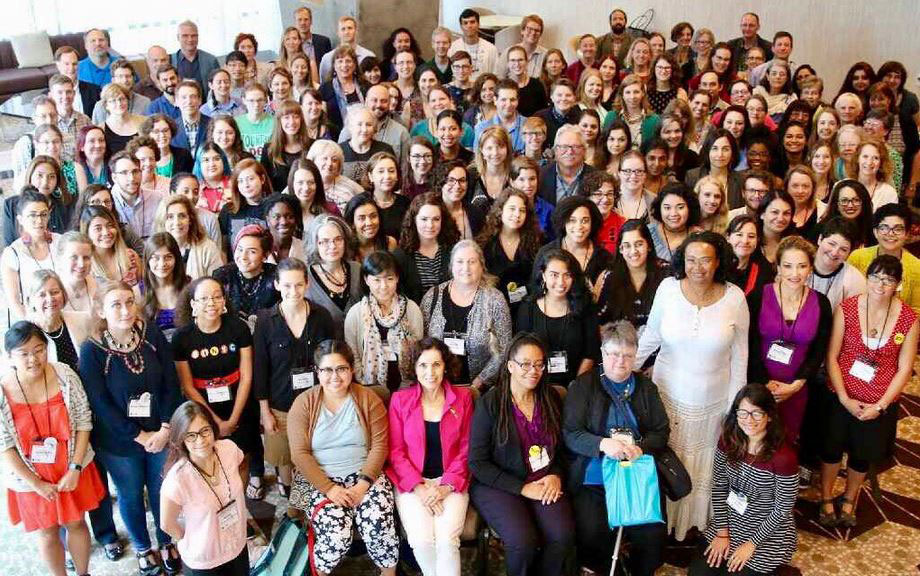
Women in Astronomy IV attendees
[click to enlarge]
Women in Astronomy IV: The Many Faces of Women Astronomers, a conference sponsored by the National Radio Astronomy Observatory (NRAO) and the American Astronomical Society (AAS), with support from the National Science Foundation (NSF), took place 9 - 11 June 2017, following the 2017 AAS Summer Meeting in Austin, Texas. Photographs, videos, and presentations are archived at the meeting website.
2017 Jansky Lectureship Awarded to Dr. Bernard Fanaroff
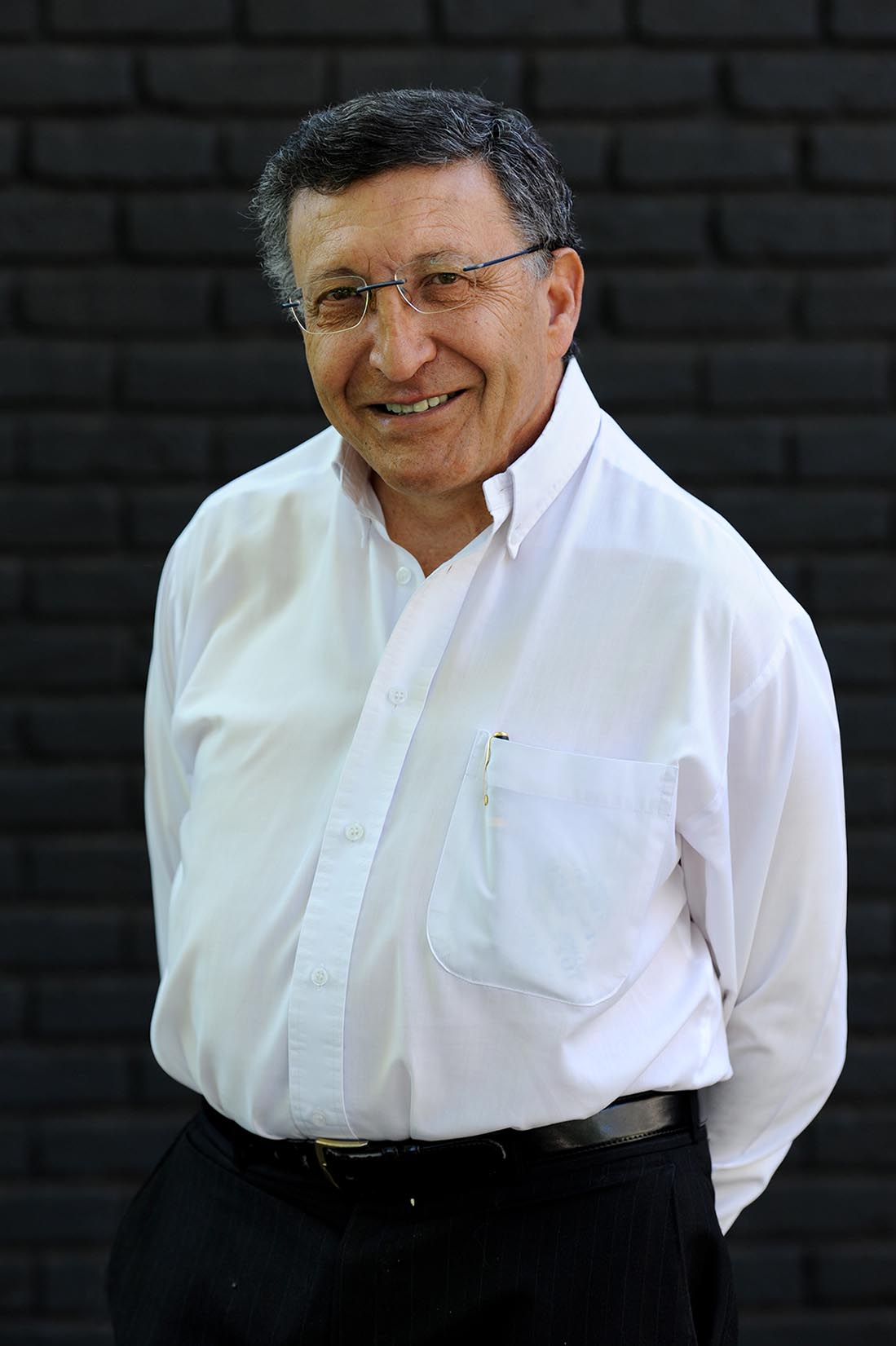
Dr. Bernard Fanaroff
[click to enlarge]
Associated Universities, Inc. (AUI), and the National Radio Astronomy Observatory (NRAO) have awarded the 2017 Karl G. Jansky Lectureship to Dr. Bernie Fanaroff, recently retired from the SKA (Square Kilometre Array) South Africa. The Jansky Lectureship is an honor established by the trustees of AUI to recognize outstanding contributions to the advancement of radio astronomy.
Dr. Fanaroff, as the 2017 Jansky Lecturer, is being recognized for his exceptional contributions to radio astronomy and his unparalleled leadership through public service. He will present his Lecture – Observing the Universe from Africa: Linking Radio Astronomy and Development – on the following dates at these AUI-managed research facilities:
| NRAO – Charlottesville, VA | Wednesday, 25 October 2017 |
| Green Bank Observatory, WV | Friday, 27 October 2017 |
| NRAO – Socorro, NM | Friday, 3 November 2017 |
This is the fifty-second Jansky Lectureship. First awarded in 1966, it is named in honor of the man who, in 1932, first detected radio waves from a cosmic source. Karl Jansky's discovery of radio waves from the central region of the Milky Way started the science of radio astronomy.
Futures III Conference: 2 - 4 Aug 2017
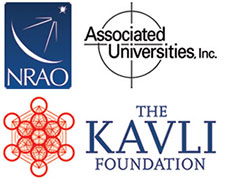
The NRAO has organized a series of three conferences for the community to broadly discuss and seek consensus regarding potential U.S. futures for radio-millimeter-submillimeter (RMS) science in the 2020s and beyond. Funded by the Kavli Foundation and Associated Universities, Inc., the third and final conference in this series – Futures III – will be 2-4 August 2017 in Berkeley, California and will be attended by scientists from U.S. and international universities, observatories, and laboratories in virtually every field of astrophysics.
Registration for Futures III is now open; the scientific program and travel information are now available at the conference website.
Futures III will continue discussions and analysis of two key opportunities emerging from the Futures I and Futures II conferences – a next generation Very Large Array (ngVLA) and Spectral-Line Cosmology & Low Frequency Instruments, including the Hydrogen Epoch of Reionization Array (HERA) and related intensity mapping opportunities. An update on other key areas – Cosmic Microwave Background, Pulsars, and Midscale developments – is also planned. Over the past two years, the Kavli meeting series has been a community-wide effort to explore our scientific visions for the next decade, and seeking to develop consensus and support for RMS initiatives on all resource scales in the upcoming decadal survey.
Futures I was held 15-17 December 2015 in Chicago and was structured around the key RMS science themes and community priorities identified in the Astro2010 Decadal Survey. This included fields where radio data was supporting other instruments, and those focused on possible standalone radio astronomy outcomes. Futures I yielded a compelling definition of the transformational science that interests the community and motivates the exploration of the scope and feasibility of the future RMS instrument and technique options.
The community and NRAO selected four areas for deeper discussion at the Futures II Conference, held 3-5 August 2016 in Baltimore: (1) a next generation Very Large Array; (2) a Hydrogen Epoch of Reionization Array; (3) pulsar instrumental and scientific opportunities; and (4) the Cosmic Microwave Background. Parallel sessions broadly discussed potential RMS Flagship and small/midscale initiatives associated with these. Flagship options are major investments with widespread community benefit and support that would require funding by or on a scale comparable to the NSF Major Research Equipment and Facility Construction program. small/midscale initiatives are investments that might be funded via the NSF Mid-Scale Initiative Program.
Registration will be open through 17 July at the Futures III conference website. We look forward to seeing you in Berkeley in August!
Fred Lo Science Symposium & 5th U.S. – China Workshop on Radio Astronomy Science & Technology

Fred Lo
[click to enlarge]

Five-hundred-meter Aperture Spherical radio Telescope (FAST)
[click to enlarge]
The 5th U.S. – China Workshop on Radio Astronomy Science & Technology will take place in Charlottesville, Virginia, U.S.A. from 27-29 July 2017 and will be preceded by a Symposium to celebrate the life and career of former NRAO Director Fred Lo from 24-26 July. The Symposium will feature science sessions highlighting Fred's many contributions to radio astronomy throughout his career.
The Science and Technology Workshop will continue the discussions and planning held in previous years to support collaborations in joint scientific programs as well as cooperation in planning, building, and commissioning new facilities and instrumentation. Potential joint observing programs will include the Very Long Baseline Array, the new Shanghai Astronomical Observatory 65m radio telescope, the Five-hundred-meter Aperture Spherical radio Telescope (FAST), and other existing and planned U.S. and Chinese facilities. Technical discussions will include the proposed 110m QiTai radio Telescope (QTT), handling big data, space Very Long Baseline Interferometry, and back ends.
Registration for these events will be open until 10 July. Please visit the U.S. – China Workshop or Fred Lo Symposium websites to register and for additional information.
ALMA Program News
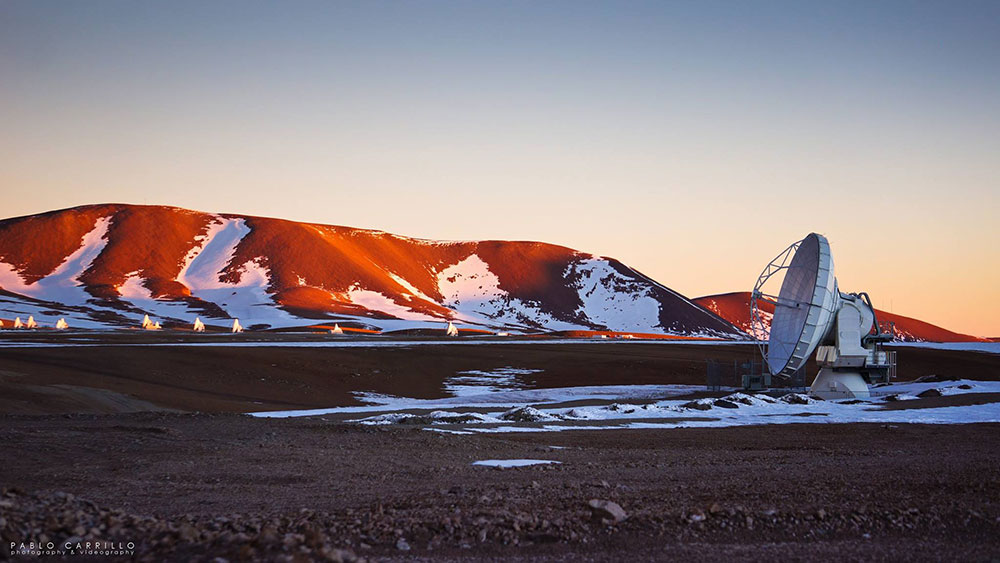
P. Carillo
[click to enlarge]
ALMA Cycles 4 and 5
Antennas are located in C40-5 – 0.54 arcsec beam at 100 GHz, 17-1100m baselines – through May and will move to the longest baselines, configuration C40-9 – 0.066 arcsec beam at 100 GHz, 0.27 -12.6 km baselines – for later observations when weather on Chajnantor allows. Configuration files are included in the recent Common Astronomy Software Applications (CASA) 4.7.2 release. Snowstorms at the ALMA site in late May and early June adversely affected operations and reduced the time available for science observations. The Total Power, ALMA Compact Array and 12m Array resumed observations recently but reconfiguration of the 12m array from the current C40-5/6 hybrid to long baselines await resolution of various problems related to exceptional winter weather.
The Call for ALMA Proposals for Cycle 5 closed on 20 April 2017. Members of the ALMA Science Review Panels met in Antwerp 19-23 June. Results are expected in late July.
A separate Supplemental Call for Proposals to use the 7-m Array in Cycle 4 closed on 15 May. Results from the Cycle 4 Supplemental Call for Proposals were posted in the ALMA Science Portal on 20 June. The Joint ALMA Observatory received 198 proposals requesting 4815 observing hours on the 7-m Array in response to the Call. A total of 32 proposals requesting 716 hours were accepted and added to the 7-m Array observing queue for the remainder of Cycle 4. The amount of time allocated is less than the 800 hours anticipated owing to the adverse effects of snowstorms at Chajnantor.
A Community Days and Proposal Planning Event will take place at Cornell University, 10-11 July.
ALMA Development: A Science Sustainability Program
A Call for Proposals for ALMA Development Studies closed 1 May 2017. The 26 proposals have been distributed to referees for assessment.
The ALMA Project to build a Band 2+ receiver, covering 67-95GHz, passed its Preliminary Design Review held in Charlottesville, Virginia, USA 30-31 May 2017. This receiver offers extended coverage over the original ALMA Band 2 specifications, covering a wider frequency range and providing twice the bandwidth of other ALMA receivers (two sidebands of 8 GHz bandwidth in two polarizations). The entire passband may be covered in two frequency settings when deployed with an upgraded correlator and digitization system. A correlator – see NAASC Memos 114 and 115 – and a digitizer upgrade to accommodate this increased functionality are in the late planning stages. A new digitization system is also in the advanced planning stages.
New NRAO Archive Access Tool
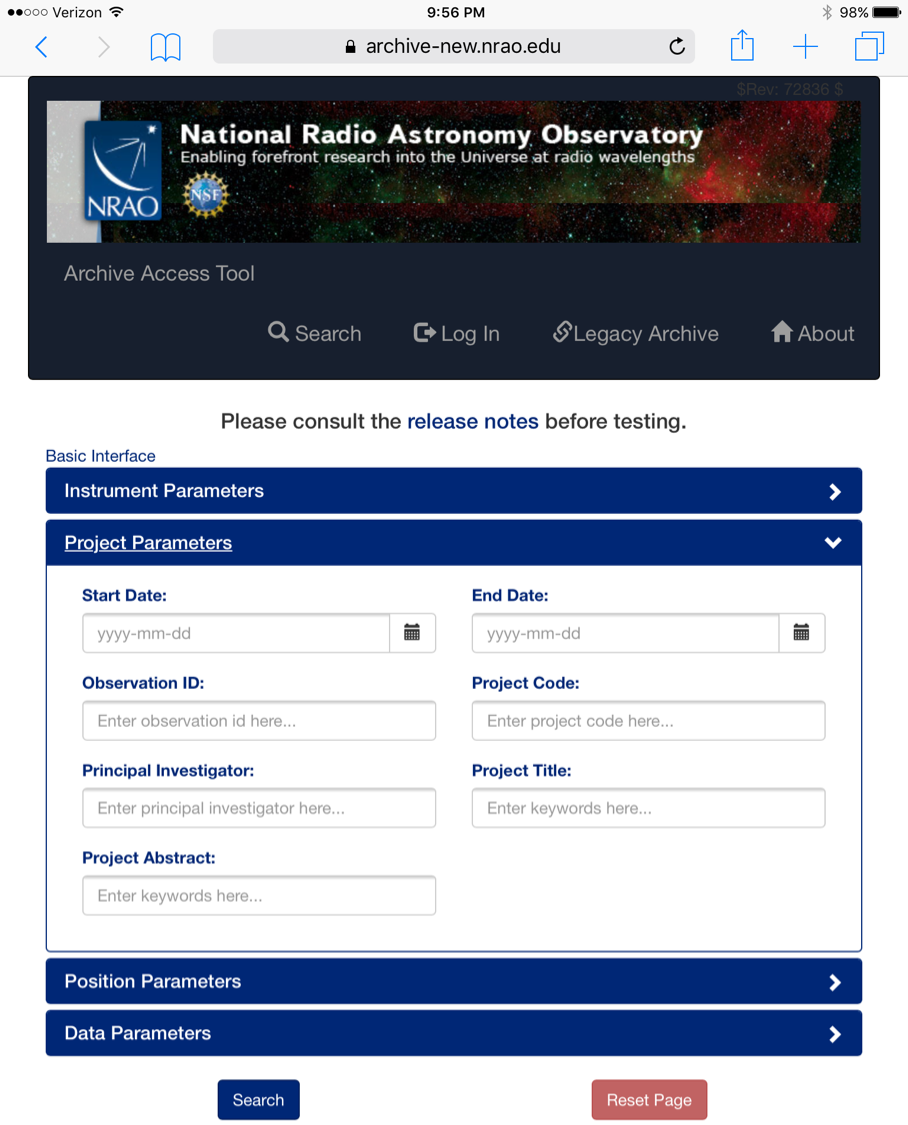
Advanced Search Interface, Tablet
[click to enlarge]
The NRAO Science Support and Archive Team announces the preliminary release of the new NRAO Archive Access Tool, now available for public use and beta testing.
This initial release allows astronomers to search and download data from our repository of 40 years of observations, from the legacy Very Large Array (VLA), Jansky VLA, Very Long Baseline Array, Green Bank Telescope, and Atacama Large Millimeter/submillimeter Array. It serves as an interface to the NRAO processing pipeline and will eventually replace the current NRAO archive access tool.
Features of the new NRAO Archive Access Tool include:
- Basic search interface, e.g., search for ‘nova’
- Advanced search interface, choose dates, frequencies, positions and more
- Integration with the Sesame service for looking up positions by name using several popular databases (NED, Simbad, VizieR)
- For Jansky VLA and ALMA only:
- Download as CASA Measurement Set and filter on Scan Intent
- Simple reprocessing: re-run the calibration pipeline
- Responsive interface that works on mobile devices
- My Data: login, click a link and see all your projects
Since this is the initial public release of the tool, there are bound to be bugs, unintended features, and other frustrations. We appreciate your patience and value your help in finding these so we can address them in the next release. Please report your discoveries and feedback to the Archive Department of the NRAO Helpdesk.
We recommend users read the release notes, which we will keep up to date with details about known issues as we find them:
2017 NRAO–GBO Summer Student Workshop

National Radio Astronomy Observatory (NRAO) and Green Bank Observatory (GBO) summer students visited Green Bank, West Virginia 5 -9 June for the 2017 Summer Student Workshop, affectionately nicknamed the Radio Astronomy Bootcamp. The students attended lectures on radio astronomy fundamentals from NRAO and GBO staff, learned about instrumentation and observatory operations, and enjoyed several science talks, including a keynote presentation by Duncan Lorimer (WVU) on Fast Radio Bursts. The students also participated in team-based observing projects, received an introduction to pulsar data analysis, and toured the Green Bank Telescope and the Green Bank site. Discussions on career building and applying to graduate school were high points for many of the attendees. Finally, after hearing tips on public speaking, each student team gave a presentation on their observing project to their classmates. An enriching week for all!
Recent Media Releases
Career Opportunities
CASA Lead: The NRAO is actively seeking a candidate with a combination of software, management, and ideally, astronomy experience to join the Data Management and Software Department as the CASA Group Lead. The CASA Group is responsible for the Common Astronomy Software Applications (CASA) package, and the CASA pipelines, which provide heuristic-based automated processing for calibration and imaging. The position will be located either in Charlottesville, Virginia or in Socorro, New Mexico.
Scientist (Open Rank): Associated Universities, Inc. is actively seeking an enthusiastic and energetic scientist to join the staff of the Green Bank Observatory in Green Bank, West Virginia. The Green Bank Observatory oversees the development and operation of the Robert C. Byrd Green Bank Telescope (GBT), the world’s largest fully-steerable telescope, as well as numerous smaller telescopes, which are used for a variety of scientific and educational purposes.
From the Archives
Ellen Bouton

Maryland Point 85-foot Telescope
[click to enlarge]
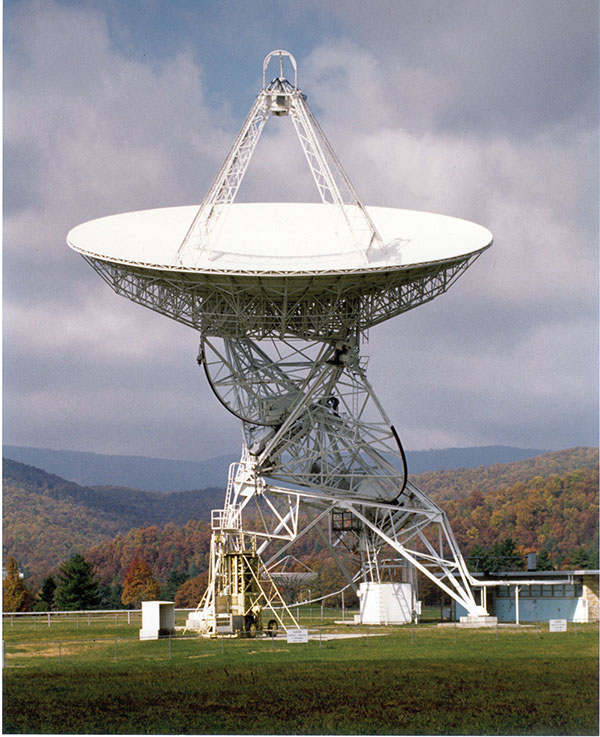
Green Bank 85-foot Tatel Telescope
[click to enlarge]
About this month's photo: Fifty years ago, the results of the first successful use of the NRAO-Cornell independent oscillator-tape-recording interferometer for very long baseline interferometry (VLBI) were published in the 17 July 1967 issue of Science by Claude Bare, Barry Clark, Ken Kellermann, Marshall Cohen and Dave Jauncey. This MK-1 VLBI system used a standard computer tape drive to record one-bit data at 720 kilobits per second. Each pair of tapes lasted only 3 minutes and took about one hour to process on an IBM 360-50 computer. The past half-century of VLBI has seen numerous upgrades to recorders and correlators. The MK-5 system currently in use for the Very Long Baseline Array and throughout the world uses computer disk drives to record at 2 Gbps giving a factor of 50 improvement in sensitivity over the 1967 system. The Mk-1 software correlator was soon replaced by a series of hardware correlators of ever increasing capabilities leading to the recent return to the Distributed FX (DiFX) software correlator. The photographs show the two antennas used in the May 1967 experiment, the Maryland Point 85-foot and the Green Bank 85-foot Tatel Telescope. Thanks to Ken Kellermann for caption information.
From the Archives is an ongoing series illustrating NRAO and U.S. radio astronomy history via images selected from our collections of individuals' and institutional papers. If readers have images they believe would be of interest to the Archives, please contact Ellen Bouton.


